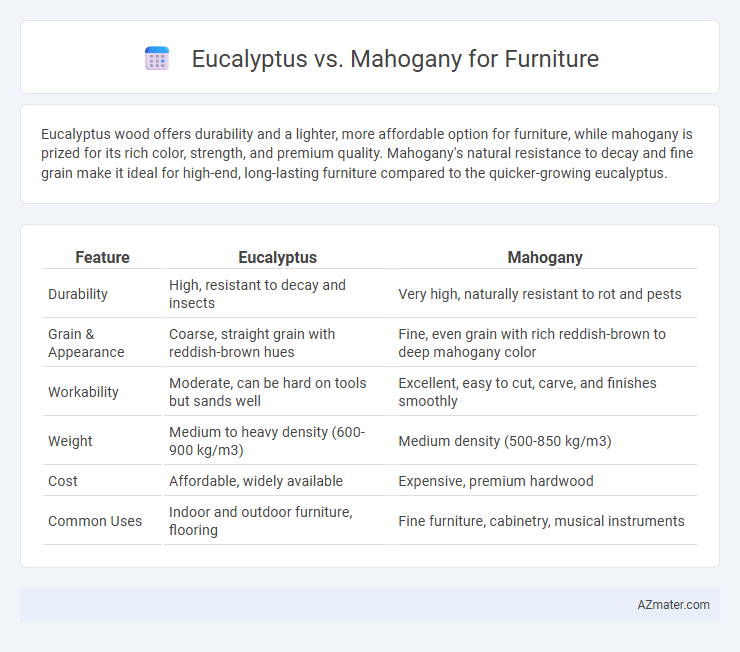Eucalyptus wood offers durability and a lighter, more affordable option for furniture, while mahogany is prized for its rich color, strength, and premium quality. Mahogany's natural resistance to decay and fine grain make it ideal for high-end, long-lasting furniture compared to the quicker-growing eucalyptus.
Table of Comparison
| Feature | Eucalyptus | Mahogany |
|---|---|---|
| Durability | High, resistant to decay and insects | Very high, naturally resistant to rot and pests |
| Grain & Appearance | Coarse, straight grain with reddish-brown hues | Fine, even grain with rich reddish-brown to deep mahogany color |
| Workability | Moderate, can be hard on tools but sands well | Excellent, easy to cut, carve, and finishes smoothly |
| Weight | Medium to heavy density (600-900 kg/m3) | Medium density (500-850 kg/m3) |
| Cost | Affordable, widely available | Expensive, premium hardwood |
| Common Uses | Indoor and outdoor furniture, flooring | Fine furniture, cabinetry, musical instruments |
Introduction to Eucalyptus and Mahogany
Eucalyptus wood, known for its durability and resistance to moisture, offers a sustainable and affordable option for furniture making, featuring a pale to medium brown hue with a distinct grain pattern. Mahogany, prized for its rich reddish-brown color, fine grain, and exceptional workability, has long been a premium choice for high-end furniture due to its strength and elegant finish. Both woods provide unique aesthetic and functional qualities, with eucalyptus favored for modern, eco-friendly designs and mahogany for classic, luxurious pieces.
Botanical Origins and Growth Characteristics
Eucalyptus, native to Australia, belongs to the Myrtaceae family and is known for its rapid growth and adaptability to various climates, making it a sustainable choice for furniture production. Mahogany, from the Meliaceae family, primarily originates in Central and South America and grows more slowly, resulting in denser, more durable hardwood prized for high-end furniture. The contrasting growth rates and botanical traits influence their grain patterns, color, and longevity, impacting their suitability for different furniture styles and uses.
Appearance: Color, Grain, and Texture
Eucalyptus furniture showcases a light to medium brown color with subtle reddish hues, featuring a fine, straight grain that can exhibit wavy patterns, providing a smooth texture that enhances contemporary designs. Mahogany is prized for its rich, deep reddish-brown color that darkens over time, complemented by a straight, fine, and uniform grain, offering a smooth, velvety texture ideal for classic, high-end furnishings. The color depth and grain uniformity of mahogany often result in a more luxurious appearance, while eucalyptus's lighter tone and varied grain patterns suit modern, casual aesthetics.
Durability and Longevity
Eucalyptus wood offers moderate durability and is resistant to termites and decay, making it suitable for indoor and occasional outdoor furniture with proper treatment. Mahogany is renowned for its exceptional durability and longevity, as it naturally withstands moisture, insects, and wear, often lasting decades with minimal maintenance. For long-term investment, mahogany furniture provides superior resilience compared to eucalyptus, which may require more frequent upkeep to maintain its integrity.
Resistance to Pests and Decay
Mahogany exhibits excellent resistance to pests and decay, making it a durable choice for long-lasting furniture exposed to various environmental conditions. Eucalyptus also offers decent resistance due to its dense grain and natural oils but tends to require treatment to enhance its durability against termites and fungal attacks. Choosing mahogany guarantees a higher natural resistance, while eucalyptus demands proper sealing and maintenance to maintain pest and decay protection.
Workability and Ease of Crafting
Eucalyptus wood offers excellent workability with its medium density and consistent grain, making it easy to machine, sand, and finish for furniture projects. Mahogany, prized for its fine grain and smooth texture, is renowned for its ease of hand carving and shaping, allowing detailed craftsmanship with minimal effort. Both woods provide a balance of durability and aesthetic appeal, but eucalyptus is often favored for quicker production, while mahogany excels in high-end, intricate designs.
Environmental Impact and Sustainability
Eucalyptus furniture offers a more sustainable option due to its rapid growth rate and ability to be harvested within 10 years, reducing deforestation pressures compared to Mahogany, which takes decades to mature. Mahogany is often associated with illegal logging and habitat destruction, contributing to significant environmental degradation in tropical rainforests. Choosing eucalyptus supports eco-friendly practices by promoting fast-renewing wood resources and minimizing carbon footprint in furniture production.
Cost Comparison and Market Value
Eucalyptus furniture typically offers a lower cost compared to mahogany, making it an economical choice for budget-conscious buyers without sacrificing durability. Mahogany commands a higher market value due to its rich grain, exceptional hardness, and long-lasting appeal, often appreciated in high-end and luxury furniture markets. The significant price difference reflects mahogany's premium status and limited availability, whereas eucalyptus is more abundant and sustainable, impacting its affordability and market demand.
Maintenance and Care Requirements
Eucalyptus furniture demands regular oiling and protection from excessive moisture to prevent cracking and warping, while mahogany requires periodic polishing to maintain its deep, rich color and resist surface scratches. Eucalyptus is more resistant to pests and decay, making it low-maintenance compared to mahogany, which needs vigilance against humidity fluctuations that can cause swelling or shrinking. Both hardwoods benefit from cleaning with mild soap and water, but mahogany's fine grain calls for gentler care to preserve its smooth finish.
Which Wood is Better for Your Furniture?
Eucalyptus wood offers durability, resistance to moisture, and affordability, making it ideal for outdoor furniture and eco-friendly projects. Mahogany stands out with its rich color, fine grain, and superior strength, favored for high-end, classic indoor furniture. Choosing between eucalyptus and mahogany depends on your priorities: cost-efficiency and weather resistance versus aesthetic appeal and long-lasting luxury.

Infographic: Eucalyptus vs Mahogany for Furniture
 azmater.com
azmater.com